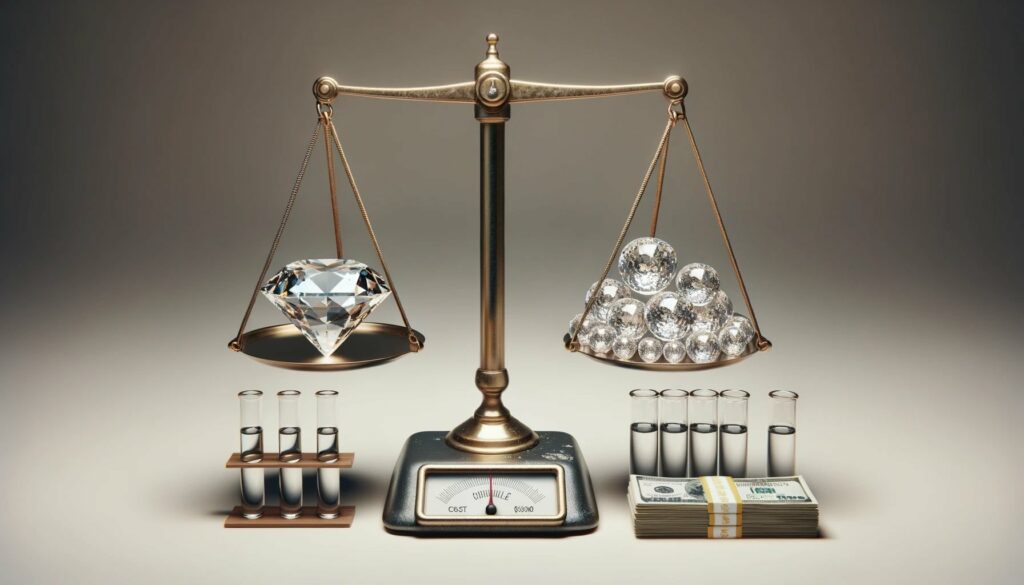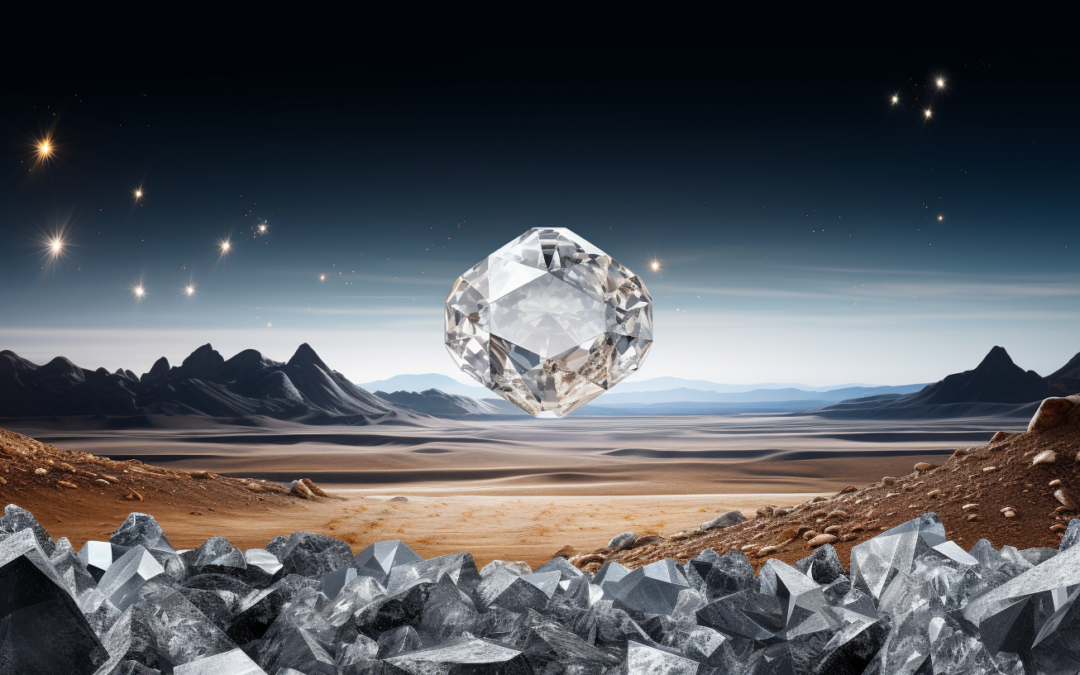Article Contents
- 1 Key Takeaways
- 2 Diamond Formation: Natural Vs. Synthetic
- 3 Environmental Impact: Mining vs. Lab Creation
- 4 Diamond Quality: Comparing Clarity and Color
- 5 Cost Comparison: Mined vs. Lab-Grown Diamonds
- 6 Consumer Perception: Shifting Views on Lab-grown Diamonds
- 7 Frequently Asked Questions On The Comparison Between Mined and Lab-grown Diamond Jewellery
- 7.1 Are Lab-Grown Diamonds as Durable as Natural Diamonds?
- 7.2 Can Lab-Grown Diamonds Be Distinguished From Natural Diamonds by Experts?
- 7.3 Do Lab-Grown Diamonds Have the Same Resale Value as Natural Diamonds?
- 7.4 How Long Does It Take to Grow a Lab-Grown Diamond?
- 7.5 Are Lab-Grown Diamonds Considered Ethically Superior to Natural Diamonds?
- 8 References Used In This Article
In the world of diamonds, there’s a growing trend that’s sparking debates and shifting perceptions. Mined vs. lab-crafted diamonds are at the forefront of this conversation. In recent years, lab-crafted diamonds have gained popularity due to their ethical production and lower environmental impact, challenging the long-standing dominance of traditionally mined gems. This shift aligns with emerging genderneutral jewelry trends, as consumers increasingly seek designs that transcend traditional gender norms and embrace individuality. As a result, the diamond industry is evolving to cater to a more diverse and conscientious audience.
This comparison between mined and lab-grown diamonds aims to shed light on the differences between these two types of diamonds. From formation to environmental impact diamond quality to cost comparison, we seek to provide concise, factual information for an audience that values freedom of choice.
Get ready to explore the fascinating world of diamonds and make an informed decision.
Key Takeaways
- Natural diamonds are formed over billions of years, while synthetic diamonds are created in a laboratory using various techniques.
- Mined diamonds have a significant environmental impact, causing land disturbance, deforestation, and water usage, while lab-grown diamonds have a lower carbon footprint and do not require extensive land use or water consumption.
- Lab-grown diamonds often have higher clarity grades and can be produced in fancy colours, while mined diamonds can have a wide range of colours.
- Lab-grown diamonds offer a more affordable option compared to mined diamonds, as the streamlined production process reduces overall costs.
Diamond Formation: Natural Vs. Synthetic
The formation of diamonds, whether natural or synthetic, plays a crucial role in understanding their value and origin. When it comes to diamond authenticity, knowing the difference between natural and synthetic diamonds becomes essential in today’s diamond market.
Natural diamonds are formed deep within the Earth’s mantle under immense pressure and heat. They’re created over billions of years through a natural process involving carbon atoms bonding together. The rarity and natural beauty of these diamonds contribute to their high value in the market.
On the other hand, synthetic diamonds are created in a laboratory using various techniques. These diamonds have the same chemical composition as natural diamonds but are grown in a controlled environment. They’re typically made using high-pressure, high-temperature (HPHT) or chemical vapour deposition (CVD) methods. Synthetic diamonds offer an alternative to natural diamonds and are becoming increasingly popular in the market due to their lower cost and ethical considerations.
Understanding the formation process of diamonds, whether natural or synthetic, provides valuable insights into their authenticity and value. While natural diamonds are cherished for their rarity and natural origin, synthetic diamonds offer an affordable and sustainable option for those who desire the beauty of diamonds without the ethical concerns. The debate surrounding natural vs synthetic diamonds often centers on personal values, budget considerations, and environmental impact. Natural diamonds form over billions of years under intense heat and pressure deep within the Earth, making them a marvel of geological history. In contrast, synthetic diamonds are created in controlled laboratory environments, replicating the same chemical composition but catering to modern demands for sustainability and accessibility.
Environmental Impact: Mining vs. Lab Creation
While both mined and lab-crafted diamonds have environmental impacts, the methods of diamond formation differ significantly in terms of their ecological footprint. Mined diamonds are extracted from the earth through mining processes, which can have a significant carbon footprint and cause environmental damage. On the other hand, lab-created diamonds are grown in controlled laboratory environments using sustainable practices without the need for extensive mining operations.
To compare the environmental impact of mining versus lab creation, a table is presented below:
| Environmental Impact | Mined Diamonds | Lab-Created Diamonds |
|---|---|---|
| Carbon Footprint | High | Low |
| Land Disturbance | Yes | No |
| Water Usage | High | Low |
| Energy Consumption | High | Moderate |
| Sustainability Initiatives | Varies | High |
Mined diamonds contribute to a high carbon footprint due to the energy-intensive mining operations and the transportation of rough diamonds. Additionally, mining can lead to land disturbance, deforestation, and soil erosion. Water usage is also high in mining, with large amounts required for processes like extraction and washing. In contrast, lab-crafted diamonds have a lower carbon footprint as the energy consumption is moderate, and they do not require extensive landorr water consumption. Moreover, lab-grown diamond producers often prioritize sustainability initiatives, making them a more environmentally friendly choice.
Diamond Quality: Comparing Clarity and Color
Comparing clarity and colour, both mined and lab-crafted diamonds exhibit variations in their diamond quality. Diamond grading plays a crucial role in determining the value and desirability of a diamond.
Clarity refers to the presence of internal or external flaws, known as inclusions and blemishes, respectively. Mined diamonds, being natural, often have more inclusions and blemishes compared to lab-crafted diamonds, which are created in controlled environments. However, advancements in technology have allowed lab-grown diamonds to achieve higher clarity grades, making them comparable to their mined counterparts.
Colour is another important aspect of diamond quality. The Gemological Institute of America (GIA) grades diamond colour on a scale ranging from D (colourless) to Z (light yellow or brown). Mined diamonds can have a wide range of colours, while lab-grown diamonds are typically created to be colourless or near-colourless. However, lab-grown diamonds can also be produced in fancy colours such as blue, pink, and yellow.
Market demand for diamond quality varies depending on personal preferences and trends. Some consumers prioritize the highest clarity and colour grades, while others may value the uniqueness and affordability of lab-grown diamonds. Ultimately, it’s important for consumers to consider both clarity and colour when making a decision about diamond quality, taking into account their individual preferences and budget.
Cost Comparison: Mined vs. Lab-Grown Diamonds
Mined and lab-grown diamonds differ in cost. A small number of dominant players have long dominated the market for mined diamonds, driving up consumer prices. The scarcity and labour-intensive process of mining diamonds contribute to their high cost.
On the other hand, the lab-grown diamond industry has been growing rapidly in recent years, offering an alternative option at a more affordable price point. Lab-grown diamonds are created in a controlled environment using advanced technology. This streamlined process allows for more efficient production, reducing the overall cost.
Additionally, the lab-grown diamond industry has a more competitive market, with several companies vying for market share. This competition drives prices down, making lab-grown diamonds more accessible to a wider range of customers.
It is important to note that while lab-grown diamonds are generally more affordable, their prices can still vary depending on factors such as size, cut, and quality. However, in general, lab-grown diamonds cost around 30–40% less than their mined counterparts.
Ultimately, the cost difference between mined and lab-grown diamonds makes the latter an attractive option for those seeking a more budget-friendly alternative without compromising on quality. As consumers become more aware of the ethical and environmental concerns surrounding diamond mining, lab-grown diamonds offer a guilt-free alternative. Additionally, with aging mines and supply constraints becoming more of a concern, lab-grown diamonds provide a sustainable and reliable option for the future. This combination of affordability, quality, and ethical sourcing positions lab-grown diamonds as a compelling choice in the jewelry market.
Consumer Perception: Shifting Views on Lab-grown Diamonds
Many consumers have begun to embrace lab-grown diamonds due to their increasing affordability and ethical appeal. As ethical concerns surrounding the diamond industry continue to grow, more people are seeking alternatives that align with their values. Lab-grown diamonds, also known as cultured or synthetic diamonds, are created in a controlled environment using advanced technology. They have the same physical and chemical properties as natural diamonds but are grown in a fraction of the time.
This process eliminates the need for environmentally destructive mining practices and reduces the social impact associated with traditional diamond mining.
Furthermore, lab-grown diamonds are often priced significantly lower than their mined counterparts. This affordability factor has contributed to the growing market demand for lab-grown diamonds. Consumers are increasingly recognizing that they can purchase a high-quality diamond without breaking the bank or compromising their ethical values. The shift in consumer perception towards lab-grown diamonds is evident in the rising popularity of brands and retailers that specialize in these alternatives.
As more people become aware of the ethical and cost benefits of lab-grown diamonds, their demand is expected to continue to rise. This shift reflects a changing mindset among consumers who value sustainability, transparency, and ethical sourcing in their purchasing decisions.

Frequently Asked Questions On The Comparison Between Mined and Lab-grown Diamond Jewellery
Are Lab-Grown Diamonds as Durable as Natural Diamonds?
Lab-grown diamonds are as durable as natural diamonds. Both types have the same chemical composition and hardness. The manufacturing process for lab-grown diamonds replicates the conditions under which natural diamonds are formed, resulting in comparable durability.
Can Lab-Grown Diamonds Be Distinguished From Natural Diamonds by Experts?
Experts cannot easily distinguish lab-grown diamonds from natural diamonds. This poses challenges for the lab-grown diamond industry and the assurance of diamond authenticity in the market. Traditional diamond mining has long been associated with labor exploitation and environmental destruction. The rise of lab-grown diamonds as a more ethical and sustainable alternative has led to increased demand for these stones. However, the difficulty in distinguishing lab-grown diamonds from natural ones complicates efforts to ensure that consumers are truly getting what they pay for, whether it be an ethically sourced lab-grown diamond or a responsibly mined natural diamond.
Do Lab-Grown Diamonds Have the Same Resale Value as Natural Diamonds?
Lab-grown diamonds may not have the same resale value as natural diamonds due to differences in market demand. However, their environmental impact is often considered more favourable, making them an attractive choice for those seeking freedom and sustainability.
How Long Does It Take to Grow a Lab-Grown Diamond?
It takes several weeks to grow a lab-grown diamond through a growth process that replicates the natural formation of diamonds. This method has a lower environmental impact compared to mining. In addition to being more sustainable, lab-grown diamonds are indistinguishable from mined diamonds in terms of quality and beauty. This makes them an attractive option for those looking for ethically sourced and environmentally friendly diamonds. Furthermore, the labgrown diamond jewellery production process follows strict ethical and labor practices, ensuring that the entire process from growth to production is responsible and sustainable.
Are Lab-Grown Diamonds Considered Ethically Superior to Natural Diamonds?
Lab-grown diamonds are often considered ethically superior to natural diamonds due to their lower environmental impact and lack of human rights concerns. The sustainable and transparent production process of lab-grown diamonds addresses ethical implications and sustainability concerns.
References Used In This Article
- Lab Diamonds vs Mined Diamonds Price Comparisons: https://news.thediamondstore.co.uk/gemstones-birthstones/diamond-learning/lab-diamonds-vs-mined-diamonds-price-comparisons/
- Lab Diamonds vs Real Diamonds: https://www.queensmith.co.uk/diamond-guides/lab-grown-diamonds/lab-diamonds-vs-natural-diamonds
- Everything You Need To Know About Lab-Grown Vs Mined Diamonds: https://www.vogue.co.uk/fashion/article/mined-lab-grown-diamonds
- Is There a Difference Between Natural and Laboratory-Grown Diamonds?: https://www.gia.edu/gia-news-research/difference-between-natural-laboratory-grown-diamonds

